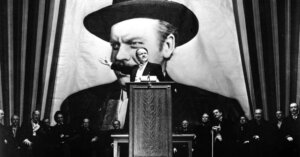The Top Five Orson Welles' Movies


Reviewed and approved by the psychologist Sergio De Dios González
When we talk about historical film directors, we have to mention those who stood out for also participating as actors, screenwriters, and producers. In other words, they became versatile filmmakers. One such character was Orson Welles. In this article, we’re going to talk about five of his best movies.
Orson Welles was born in the United States. He was renowned for shooting films in which action, reflection, and morality predominated. In addition, he was recognized for revitalizing the theater, updating the way radio shows were performed, and showing places from all over the world on the big screen. In fact, he was a teacher. Let’s get to know him a little better through five of his productions.
1. Citizen Kane
In 1941, Orson Welles made one of the great dramatic masterpieces of cinema. In this movie, he wasn’t only the director, but the writer, producer, and main actor as well. It received an Oscar for best screenplay, which he wrote with Herman Jacob Mankiewicz. It was also nominated in other categories. So what is it about this movie that makes it so iconic?
The plot focuses on the figure of Charles Foster Kane, an enormously wealthy newspaper publisher, and industrial magnate. When he died, his last word was ‘Rosebud’. Nobody understood what it meant and one particular journalist was given the job to find out.
In this movie, Orson Welles used the technique of flashbacks, applied in a bold and consistent way. In fact, they capture the viewer’s attention from start to finish.
“A writer needs a pen; an artist needs a brush, but a filmmaker needs an army.”
-Orson Welles-
2. The Lady from Shanghai
In 1947, Orson Welles carried out this film noir production. He participated as an actor with his wife, Rita Hayworth. Intrigue, emotion, and suspense are present from the start. The overriding theme is that of deception and double-crossing.
The plot centers on the figure of Michael O’Hara, a young sailor who falls deeply in love with Elsa Bannister. He signs on as a seaman on her husband’s yacht. From there, the bulk of the plot unfolds, as Michael finds himself involved in a complex murder plot and is implicated as the perpetrator.
3. The Third Man
Two years later, in 1949, Carol Reed directed this movie which was really well received by the Academy. It falls within the genre of film noir. In it, Orson Welles appears as one of the protagonists, along with Joseph Cotten and Alida Valli. Let’s take a look at it:
- The plot is set in Berlin after the end of World War II when different territories were controlled by powers such as France, Great Britain, the USA, and the USSR.
- The plot unfolds with the investigation of a suspected murder. This theme is mixed with one related to the black market and smuggling.
- On a technical level, it’s brilliant and every detail is taken care of. Furthermore, each character is portrayed in a unique way. In fact, despite its low budget, it’s considered one of the best films of all time.
4. The Stranger
In this movie, which is again within the genre of film noir and typical of psychological thrillers, the theme relates to the Nazis. It’s worth bearing in mind that it was shot in 1946, a date close to the end of the Second World War.
Wilson is an agent of the United Nations War Crimes Commission. His objective is to find Franz Kindler, one of the main brains of the Nazi death camps.
This film should perhaps be considered as one of Welles’ masterpieces, but it tends to be relegated to the background compared to some of his more recognized films.
“I don’t regard my career as something so precious that it comes before my convictions.”
-Orson Welles-
5. Touch of evil
This film was shot in 1958 and, like the previous ones, falls in the genre of film noir. Its theme centers around the solving of a murder. Charlton Heston and Janet Leigh star alongside Orson Welles who plays a corrupt policeman named Hank Quinlan.
Quinlan provides false evidence and it’s Ramon Miguel Vargas, the protagonist, who discovers this fact, linking Quinlan and the other gangsters to the murder.
This is one of the most outstanding works of Welles. In fact, it’s reminiscent of a Hitchcock movie.
All cited sources were thoroughly reviewed by our team to ensure their quality, reliability, currency, and validity. The bibliography of this article was considered reliable and of academic or scientific accuracy.
- Bartolomé, J. P. y Thomas, F. (2007). Orson Welles en acción. Akal. Madrid.
- Chion, M. (1992). El cine y sus oficios. Madrid. Cátedra.
- García García, A. (2011). Psicología y cine: vidas cruzadas. UNED. Madrid.
- Sullà, E. (2014). SOBRE LA FORMACIÓN DEL CANON DEL CINE NEGRO. 452ºF. Revista De Teoría De La Literatura Y Literatura Comparada, (3), 13–28. Recuperado a partir de https://revistes.ub.edu/index.php/452f/article/view/10782.
This text is provided for informational purposes only and does not replace consultation with a professional. If in doubt, consult your specialist.








